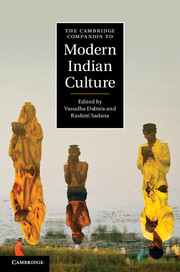Book contents
- Frontmatter
- Introduction
- Part I Cultural contexts
- Part II Cultural forms
- 6 The Bengali novel
- 7 Writing in English
- 8 Dalit life stories
- 9 National tradition and modernist art
- 10 Mass reproduction and the art of the bazaar
- 11 Urban theatre and the turn towards ‘folk’
- 12 Aesthetics and politics in popular cinema
- 13 Musical genres and national identity
- 14 Voyeurism and the family on television
- Further reading
- Index
- Cambridge Companions to Culture
10 - Mass reproduction and the art of the bazaar
from Part II - Cultural forms
Published online by Cambridge University Press: 28 May 2012
- Frontmatter
- Introduction
- Part I Cultural contexts
- Part II Cultural forms
- 6 The Bengali novel
- 7 Writing in English
- 8 Dalit life stories
- 9 National tradition and modernist art
- 10 Mass reproduction and the art of the bazaar
- 11 Urban theatre and the turn towards ‘folk’
- 12 Aesthetics and politics in popular cinema
- 13 Musical genres and national identity
- 14 Voyeurism and the family on television
- Further reading
- Index
- Cambridge Companions to Culture
Summary
The visual field in India underwent rapid transformation from the middle of the nineteenth century onward. This was due to an increased circulation of pictorial techniques and images from Europe and elsewhere, and to the introduction of technologies of mass-reproduction such as lithographic printing, photography and eventually cinema. New pictorial forms developed through a relay of three distinct elements: existing iconographic and artistic traditions, modern practices of fine art introduced in the colonial era and – in the twentieth century – elements of both local and global popular cultures. These forms were enthusiastically taken up as part of a growing Indian culture industry, particularly in the vernacular business arena that emerged from the trading communities of what historians have called the ‘bazaar’. Mass reproduction and commodification allowed images to become more mobile and thus circulate in an arena delinked from the territorial and symbolic control of temples and courts. As naturalism and realist techniques provided an alternative to strict iconographic codes, and access to images no longer depended exclusively on the intercession of priests or membership of a particular caste or class, commercially available images came to address – and indeed to constitute – differently composed audiences. These newly commercialized images then became available to the various projects of identity formation that have come to characterize Indian modernity – projects of nation, region, sect, caste and language, as well as the political and ideological projects of the nascent nation-state.
- Type
- Chapter
- Information
- The Cambridge Companion to Modern Indian Culture , pp. 184 - 205Publisher: Cambridge University PressPrint publication year: 2012
- 10
- Cited by



